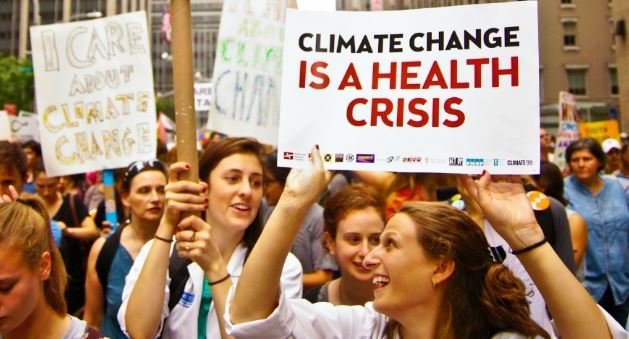Climate change is no longer a distant threat; it is a current reality manifesting through increased frequency and intensity of heat waves, rising levels of pollution, and an alarming surge in natural disasters. These environmental changes are not just altering our ecosystems; they are profoundly impacting human health, particularly among the most vulnerable groups in society—pregnant women, new-borns, children, adolescents, and the elderly. The urgency of addressing these health impacts through targeted interventions has never been greater.
Heat waves are becoming more frequent and severe due to climate change. According to a report by the World Health Organization (WHO), each additional degree Celsius increase in daily minimum temperature above 23.9 degrees Celsius significantly raises health risks, particularly for infants and the elderly. For instance, every degree increase in minimum temperature correlates with a 22.4% rise in infant mortality. The elderly, who often have pre-existing health conditions, are particularly susceptible to heat-related illnesses such as heatstroke, dehydration, and exacerbated cardiovascular and respiratory conditions. The 2024 heat wave in Asia, which saw temperatures soar to 110 degrees Fahrenheit in India, is a stark reminder of the deadly impact of extreme heat. This heat wave caused widespread disruptions, forcing schools to close and leading to hundreds of fatalities. Air pollution, driven by emissions from industrial activities, vehicular traffic, and wildfires, poses severe health risks across all life stages. Pregnant women exposed to high levels of pollution face an increased risk of adverse birth outcomes, including preterm birth, stillbirth, hypertension, and gestational diabetes. These conditions not only endanger the mother’s health but also have long-term implications for the child’s health and development. Children exposed to air pollution are at a higher risk of developing respiratory diseases such as asthma, bronchitis, and other chronic conditions. The elderly, who often have compromised immune systems and pre-existing health conditions, are also at increased risk of respiratory and cardiovascular diseases due to air pollution. Climate change is contributing to an increase in the frequency and severity of natural disasters such as floods, droughts, and wildfires. These events have both immediate and long-term health impacts. Floods, for instance, can lead to outbreaks of waterborne diseases such as cholera and dysentery due to contaminated water supplies. They also contribute to malnutrition by disrupting food supplies and agriculture. Droughts exacerbate water scarcity, leading to dehydration, poor sanitation, and increased prevalence of diarrheal diseases. They also have a severe impact on mental health, as communities face prolonged periods of hardship and uncertainty. The mental health impacts of natural disasters are often overlooked but can be profound, leading to increased rates of anxiety, depression, and post-traumatic stress disorder (PTSD). Wildfires, which are becoming more frequent and intense, pose direct health risks through burns and smoke inhalation. The particulate matter from wildfire smoke can travel long distances, affecting air quality and causing respiratory and cardiovascular problems even in areas far from the fire. The elderly are particularly vulnerable to these effects, as their bodies are less able to cope with the physical stress caused by poor air quality and heat. Given the severe health implications of climate change, there is an urgent need for targeted health interventions to protect vulnerable populations. These interventions should be multi-faceted, addressing both the immediate and long-term health impacts of climate change. Urban planning and infrastructure development must prioritize climate resilience. This includes designing buildings and public spaces that can withstand extreme weather conditions, improving drainage systems to prevent flooding, and creating green spaces that can help reduce urban heat islands. Accessible cooling centres and clean air shelters can provide refuge for vulnerable populations during extreme weather events. Governments must implement and enforce policies that reduce emissions and limit pollution. This includes transitioning to renewable energy sources, promoting public transportation, and implementing stricter regulations on industrial emissions. Policies that support sustainable agriculture and water management can also help mitigate the impacts of climate change on food and water security.
The time to act is now. It is imperative that we prioritize the health and well-being of our most vulnerable populations and take decisive action to mitigate the impacts of climate change. The J&K government as well should invest in early warning systems and robust public health campaigns to educate communities about heat wave safety, pollution risks, and disaster preparedness. Enhancing urban planning to create climate-adaptive environments, such as green spaces and efficient drainage systems, will mitigate the impacts of heat waves and floods. Furthermore, enforcing stringent air quality regulations and promoting renewable energy sources will reduce pollution and its associated health risks. Encouraging research and data collection on the local health impacts of climate change will provide critical insights for developing targeted interventions. By fostering collaboration between healthcare providers, policymakers, and communities, Jammu and Kashmir can build resilience against climate-related health threats. Taking these proactive steps will safeguard the health and well-being of pregnant women, new-borns, children, adolescents, and the elderly, ensuring a sustainable and healthy future for the region in the face of a changing climate.




